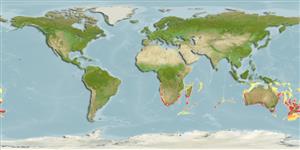Klassifizierung / Names
Namen | Synonyme | Catalog of Fishes(Gattung, Arten) | ITIS | CoL | WoRMS | Cloffa
Elasmobranchii (Haie und Rochen) (sharks and rays) >
Squaliformes (Sleeper and dogfish sharks) >
Centrophoridae (Gulper sharks)
Etymology: Deania: -ia (Gr.), belonging to: American ichthyologist Bashford Dean (1867-1928), American Museum of Natural History, for his research on selachian fishes (See ETYFish); quadrispinosa: quadri-, from quattuor (L.), four; spinosa (L.), thorny, referring to four-spined dermal denticles (See ETYFish).
Eponymy: Dr Bashford Dean (1857–1928) was an American zoologist, ichthyologist and acknowledged expert on mediaeval armour. [...] (Ref. 128868), visit book page.
Environment: milieu / climate zone / depth range / distribution range
Ökologie
seewasser bathydemersal; tiefenbereich 150 - 1360 m (Ref. 44037), usually 400 - 820 m (Ref. 6871). Deep-water; 9°S - 54°S, 12°E - 172°W (Ref. 54349)
Southeast Atlantic: off Namibia and off Algoa Bay, South Africa. Indo-West Pacific: off southern Mozambique and Natal, South Africa; Australia and New Zealand (Ref. 6871).
Length at first maturity / Size / Gewicht / Alter
Maturity: Lm ?, range 110 - ? cm
Max length : 115 cm TL Männchen/unbestimmt; (Ref. 6871)
Rückenflossenstacheln (insgesamt) : 2; Afterflossenstacheln: 0. Extremely long snout, grooved dorsal fin spines, compressed cutting teeth in both jaws, moderately large, pitchfork-shaped denticles, no subcaudal keel on underside of caudal peduncle, first dorsal fin short and high (Ref. 247). Dark brown, grey, or black in color; juveniles with a dark blotch on each dorsal fin (Ref. 26346).
A rare (Ref. 26346) and little-known species found on outer continental shelves and upper slopes (Ref. 247). Feeds on bony fishes (Ref. 247). Ovoviviparous (Ref. 50449).
Life cycle and mating behavior
Geschlechtsreife | Fortpflanzung | Ablaichen | Eier | Fecundity | Larven
Ovoviviparous, embryos feed solely on yolk (Ref. 50449). Distinct pairing with embrace (Ref. 205).
Compagno, L.J.V., 1984. FAO Species Catalogue. Vol. 4. Sharks of the world. An annotated and illustrated catalogue of shark species known to date. Part 1 - Hexanchiformes to Lamniformes. FAO Fish. Synop. 125(4/1):1-249. Rome, FAO. (Ref. 247)
IUCN Rote Liste Status (Ref. 130435: Version 2024-1)
Bedrohung für Menschen
Harmless
Nutzung durch Menschen
Fischereien: weniger kommerziell
Tools
Zusatzinformationen
Download XML
Internet Quellen
Estimates based on models
Preferred temperature (Ref.
123201): 5.5 - 12.3, mean 8.2 °C (based on 236 cells).
Phylogenetic diversity index (Ref.
82804): PD
50 = 0.5625 [Uniqueness, from 0.5 = low to 2.0 = high].
Bayesian length-weight: a=0.00389 (0.00180 - 0.00842), b=3.12 (2.94 - 3.30), in cm total length, based on all LWR estimates for this body shape (Ref.
93245).
Trophic level (Ref.
69278): 4.5 ±0.80 se; based on food items.
Widerstandsfähigkeit (Ref.
120179): niedrig, Verdopplung der Population dauert 4,5 - 14 Jahre. (Fec assumed to be <100).
Fishing Vulnerability (Ref.
59153): High to very high vulnerability (69 of 100).
